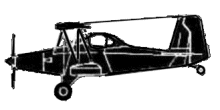
ASN Wikibase Occurrence # 298989
This information is added by users of ASN. Neither ASN nor the Flight Safety Foundation are responsible for the completeness or correctness of this information.
If you feel this information is incomplete or incorrect, you can submit corrected information.
| Date: | Thursday 18 May 2000 |
| Time: | 09:00 LT |
| Type: |  Eagle Aircraft Co. DW-1 |
| Owner/operator: | Parowan Crop Dusting Services |
| Registration: | N8803H |
| MSN: | DW-1-0023-81 |
| Total airframe hrs: | 2059 hours |
| Engine model: | Lycoming IO-540-M1B5D |
| Fatalities: | Fatalities: 0 / Occupants: 1 |
| Aircraft damage: | Substantial |
| Category: | Accident |
| Location: | BOULDER, Utah -
 United States of America United States of America
|
| Phase: | Unknown |
| Nature: | Agricultural |
| Departure airport: | PAROWAN , UT (1L9) |
| Investigating agency: | NTSB |
| Confidence Rating: |
The pilot departed Parowan, Utah, with a full load of chemical (165 gallons of Malathion ULV) and full fuel (60 gallons) en route to Boulder, Utah, (total payload approximately 1700 pounds). Towards the end of the aerial application (1,100 acres), wind velocity began increasing and, noticing that the fuel gauge registered 1/8 to 1/4 fuel remaining, the pilot turned towards Escalante, where he planned to land and refuel. Over Boulder, the fuel gauge indicated empty. The pilot briefly considered landing at Boulder, but decided the unimproved airstrip was inadequate. Five miles from Escalante and 2 miles past Boulder, the pilot realized the terrain ahead was not conducive to a forced landing. He turned back towards the Boulder airstrip. The engine lost power 1/2-mile from the airstrip. Activating the boost pump resulted in 2 seconds of engine power, enough for the airplane to cross the runway threshold. Airspeed had deteriorated to 60 mph and the airplane landed hard. The nose started to 'dip' and the pilot applied full nose up elevator. The airplane continued to nose over, crushing the vertical stabilizer.
Probable Cause: The pilot's failure to take timely remedial action when he realized a low fuel state. Factors were fuel exhaustion and low airspeed.
Accident investigation:
 |
|
Sources:
NTSB DEN00LA090
Revision history:
| Date/time | Contributor | Updates |
|---|---|---|
| 16-Oct-2022 01:11 | ASN Update Bot | Added |
Corrections or additions? ... Edit this accident description
The Aviation Safety Network is an exclusive service provided by:


 ©2024 Flight Safety Foundation
©2024 Flight Safety Foundation